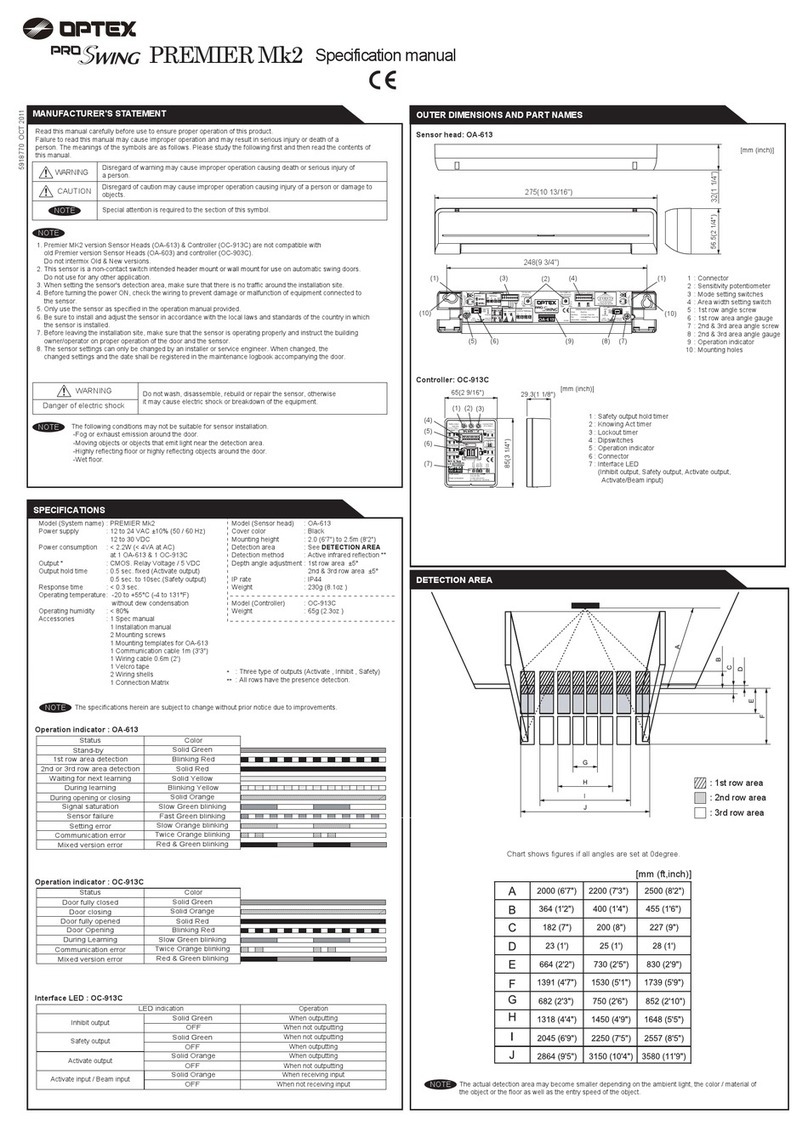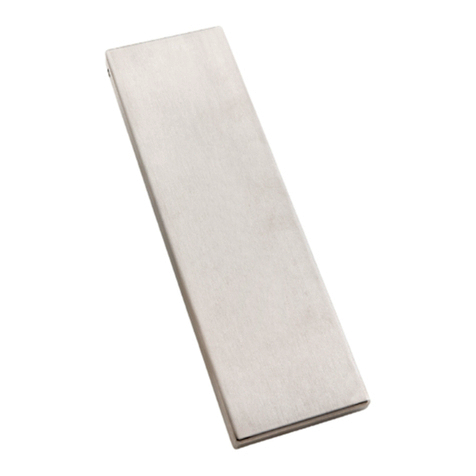
Make sure the detection area does not overlap with the door/header,otherwise ghosting/signal
saturation may occur. Do not place any highly reflecting objects in the detection area, otherwise signal
saturation may occur.
3. Dipswitch settings
8
1234 5 6 716
9101112131415
Not applicable 1,2 :Sensitivity
3,4 :Presence detection timer
5,6 :Frequency
7,8 :Row adjustment
9
10
11 to 15
16
: Snow mode
: Immunity
: Not applicable
: Installation mode
4th and 5th rows
1. Area depth angle adjustment
1st to 3rd rows
2. Width detection area adjustment
Depth angle adjustment screw
for 1st to 3rd rows
Depth angle adjustment screw
for 4th and 5th rows
1-1. Independent adjustment
1-2. Simultaneous adjustment
For the simultaneous adjustment of 1st to 5th rows, use the adjustment tool (C).
Check the area position with Red of the operation indicator using a tool such as a reflecting mirror.
Area adjustment tool
1st to 3rd rows
adjustment
4th and 5th rows and
area width adjustment
The detection area depth can be changed by
the area adjustment tool.
When adjusting the 1st to 3rd rows close to the door, follow 3-7. Installation mode.
Simultaneous
adjustment
Depth angle
adjustment screw
The actual detection area may become smaller
depending on the ambient light, the color/material
of the object and the floor as well as the entry speed
of the object.
16 16
OFF ON
3-7. Installation mode
Use this switch to ON when adjusting the presence detection area
close to the door face.
* During the installation mode, only the 1st row remain.
* Door open state
* Operation indicator glows Yellow.
Set this switch to ON, if the sensor is used in a region with snow.
3-5. Setting the snow mode
OFF ON
99
Set this switch to ON, when less influence by the header vibration is required.
3-6. Setting the immunity
10
10
OFF ON
The 5th, 4th, and 3rd rows can be eliminated
by combining dipswitches 7 and 8.
*When 2rows setting is selected, only the
presence detection area remains.
3-4. Setting the area depth
Always check the area according to the expected entry speed and determine the appropriate number
of rows.
When setting motion and motion/presence detection area sparately, make sure that there is no gap
between two areas.
5 rows
7 8 7 8 7 8 7 8
2 rows3 rows4 rows
When using more than one sensor close to each other,
set the different frequency for each sensor by combining
dipswitch 5 and 6.
3-3. Setting the frequency
Setting 1 Setting 2 Setting 3 Setting 4
5 6 5 6 5 6 5 6
3-2. Setting the presence detection timer
The 1st and 2nd rows have the presence detection function.
The presence detection timer can be selected from 4 settings.
To enable the presence detection, do not enter the
detection area for 10 s after setting the timer.
15 sec. 60 sec. 180 sec.
3 4 3 4 3 4 3 4
Normally set to "Middle". " Low" decreases the sensitivity and
"High/S-High" increases the sensitivity.
3-1. Setting the sensitivity
Low Middle High S-High
1 2 1 2 1 2 1 2
Narrow
Wide
Narrow
Wide
4th and 5th rows1st to 3rd rows
Width adjustment
screw (Right)
Width adjustment
screw (Left)
Eliminated
1210 -
Eliminated
13
-Eliminated
1210 -
Eliminated
13
-
Use the area adjustment tool (A) as shown above and
change the depth of the detection area by turning the
depth angle adjustment screw.
Red
Shallow Deep
ShallowDeep
2.0
(6'7")
1.0
(3'3")
3.0
(9'10")
3.5
(11'6")
2.0
(6'7")
3.0
(9'10")
3.5
(11'6")
2.0
(6'7")
3.0
(9'10")
2.0
(6'7")
1.0
(3'3")
1.0
(3'3")
[m(feet,inch)] [m(feet,inch)]
Shallow Deep
Blue
Use the area adjustment tool (B) as shown above and
change the depth of the detection area by turning the
depth angle adjustment screw.
ShallowDeep
3.5
(11'6")
2.0
(6'7")
3.0
(9'10")
2.0
(6'7")
1.0
(3'3")
3.0
(9'10")
3.5
(11'6")
2.0
(6'7")
3.0
(9'10")
2.0
(6'7")
1.0
(3'3")
1.0
(3'3")
[m(feet,inch)] [m(feet,inch)]
Front view
1
2
3
4567 8 9
10
11
12
2.0
(6'7")
2.0
(6'7")
2.0
(6'7")
1.0
(3'3")
1.0
(3'3")
3.0
(9'10")
3.5
(11'6")
[m(feet,inch)]
Door opens
when no one
is in the
detection area.
(Ghosting)
Door remains
open.
Door does not
open when a
person enters
the detection
area.
Door remains
closed.
None
Twice
Green
blinking
Unstable
Red
or
Orange
Slow
Green
blinking
Unstable
Proper
Proper Wrong wiring or connection failure.
Wrong wiring or connection failure.
Sensitivity is too high.
Signal saturation.
The relay is reaching the end of its
life cycle.
The detection area overlaps with the
door/header.
Vibration of the header.
Water drops on the detection window.
The detection area overlaps with that
of another sensor.
The detection area overlaps with the
door/header.
Reflecting objects in the detection area.
Or reflecting light on the floor.
Sudden change in the detection area.
Power supply voltage.
Wrong wiring or connection failure.
Dirty detection window.
It snows and pours.
Wet floor.
The exhaust emission or fog penetrate
into the detection area.
Objects that move or emit light in the
detection area.
(Ex.Plant, illumination,etc.)
Wrong detection area positioning.
Sensitivity is too low.
Short presence detection timer.
Check the wires and connector.
Check the wires and connector.
Set the sensitivity lower.
Remove the objects.
Adjust the detection area to "Deep" (Outside).
Contact your installer or the sales engineer.
Adjust the detection area to "Deep" (Outside).
Set the sensitivity lower or the immunity to ON.
Use the rain-cover (Separately available).
Or install in a place keeping the waterdrops off.
Check Adjustments 3-1 & 3-2.
If the problem still persists, hard-reset the sensor.
(Turn the power OFF and ON again.)
Set to the stated voltage.
Check the wires and connector.
Remove highly reflecting objects from the detection
area. Or lower the sensitivity.
Or change the area angle.
Check Adjustments 3-3.
Wipe the detection window with a damp cloth.
(Do not use any cleaner or solvent.)
Set the snow mode to ON.
Remove the objects.
Check the installation condition referring to
Installation on the reverse side.
Set the sensitivity higher.
Check Adjustments 1 & 2.
Set the presence detection timer longer.
Legal representative (UK only)
OPTEX (EUROPE) LTD.
Unit 13 Cordwallis Park Clivemont Road
SL6 7BU Maidenhead, Berkshire United Kingdom
Tel : +44 (0)1628 631 000
www.optex-europe.com
Manufacturer
5-8-12 Ogoto Otsu 520-0101, Japan
Tel : +81(0)77 579 8700
www.optex.net
OPTEX CO., LTD.
EMEA Subsidiary
OPTEX Technologies B.V.
Henricuskade 17, 2497 NB The Hague,
The Netherlands
Tel : +31(0)70 419 41 00
www.optex-europe.com
NOTE
NOTE
NOTE
NOTE
Adjustments
Reference
INFRARED FINDER
Detection area
Detection area
1. Turn the depth angle adjustment screw to the right (Deep) to place the detection area most away from the door.
2. Set INFRARED FINDER sensitivity to "H" (High) and place it on the floor as shown below.
3. Turn the depth angle adjustment screw to the left (Shallow) until the emitting area is placed at the position where
INFRARED FINDER is in the low detection status. (Slow Red blinking)
Area depth adjustment with INFRARED FINDER (Separately available)
Status
Green
Motion
detection active
Red Red blinking
Motion/presence
detection active
OA-AXIS I
OA-AXIS
II
Output
Entry Outside of
detection
area
Entry into
4th or 5th row
Entry into
3rd row
Entry into
2nd row
Entry into
1st row
Orange
Stand-by
Operation indicator
Presence
detection
Power OFF
-
None
*The outputs from the 3rd row overlaps.
Output from
3rd to 5th
rows
*
Output from
1st to 3rd
rows
*
White Str.
Yellow Str.
Green Str.
White
Yellow
Green
: COM.
: N.O.
: N.C.
: COM.
: N.O.
: N.C.
Check the operation in the operation mode according to the chart below.
Checking
1. When turning the power ON, always walk-test the detection area to ensure the proper operation.
2. Do not place any objects that move oremit light in the detection area. (e.g. plant, illumination, etc.)
Inform building owner/operator of the following items
1. Always keep the detection window clean. If dirty, wipe the window with a damp cloth.
Do not use any cleaner/solvent.
2. Do not wash the sensor with water.
3. Do not disassemble, rebuild or repair the sensor yourself, otherwise an electric shock may occur.
4. When the operation indicator blinks Green, contact your installer or service engineer.
5. Always contact your installer or service engineer when changing the settings.
6. Do not paint the detection window.
WARNING
NOTE
Door operation Operation
indicator Possible cause Possible countermeasures
Troubleshooting
: Can be elminated























